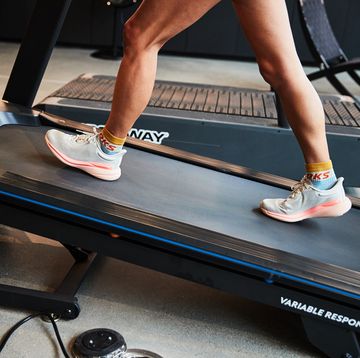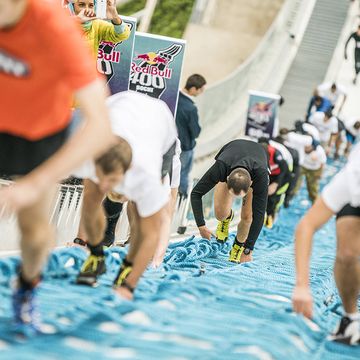I hear you're a hill lover. I'm trying to get there--and starting to train on more hilly terrain--but they suck the life out of me every time. Do you have any workouts that will help me become a hill lover, not a fighter? Thanks much! ~Nate
My name is Coach Jenny, and I love hills (maybe a little too much). It's true: If there is a fork in the road, I'll always take the hilly one because it demands my attention, develops my cardiovascular and muscular system, and mixes up the wear pattern on my body.
That said, I'll be honest with you, I used to hate hills too. My love actually arose from a mountain climbing expedition up Mount Rainier. The guide taught us to "be the mountain" and to work with it rather than against it. As Zen as it sounds, it worked! It took us two days to reach the summit and only a half-day to come back down.
The key was learning that hills are vertical challenges like mountains, and you need a strategy to run them efficiently. Once I applied my mountain climbing flow to hills, my running life changed. There was no hill too big or small that I couldn't navigate efficiently.
In order to tap into hill love, you've got to first learn to make friends with hills and run them wisely. From there, hills will become a newfound joy in your running life. Here are five of my favorite hill workouts. It's best to sprinkle them into your running routine one to two times per week.
Green Hill Repeats: These are green because this workout is all about learning how to run hills efficiently, like we did climbing that mountain.
The mission: To learn to run hills efficiently -- easy on the way up and faster on the way down, working with the flow of terrain and making friends with hills.
- Warm up with walking and easy running for 10 minutes.
- Run 10-15 minutes of hill repeats. It's best to find a hill or bridge where it takes you at least one minute to run.
- Rather than trying to conquer the hill by running it hard or trying to maintain a certain pace, run it by effort and keep it at an easy to moderate effort, where you can just hear your breathing (not hard).
- When you reach the top of the hill you should feel challenged but not spent or winded (or swearing). This is the key, as you'll be fresh enough to take advantage of the downhill.
- Run downhill focusing on letting go, opening your stride slightly, striking the ground lightly with your feet just behind your hips (rather than under), and letting the hill pull you down. Again, this shouldn't be run at a fast speed; be cautious, as downhill running increases the impact forces on the body.
- Repeat this for 10-15 minutes and cool down running 10 minutes.
Red Hill Repeats: You can pretty much guess why these are called red hills -- because that is the zone you'll be in: hard! This workout is the exact opposite of the green workout, and it simulates an interval workout in that you follow a hard and easy flow and use the hill as a source of resistance to build strength and power.
The Mission: To run hard uphill and recover downhill to build strength and power.
- Warm up walking, then run easy for 10 minutes.
- Find a hill (or treadmill) where it takes you 30-60 seconds to run up.
- Run hard up the hill focusing on keeping your stride short, torso tall, looking to the crest of the hill, and driving those elbows back. This is a dynamic interval in that you're powering up the hill, so starting with a shorter climb (30 seconds) and less time is best for newbies.
- When you reach the top, walk it out to catch your breath and then jog back down and repeat again. Like intervals, the recovery is just as important as the hill climb so make sure to invest in walking to catch your breath. Otherwise you will sacrifice form, defeating the purpose of the workout.
- Newbies start out with 10-15 minutes of hill repeats (up and down); seasoned hill runners can run longer (20-25 minutes), but keep in mind that less can be more, especially when you're pushing hard.
Mt. Rainier Hill Repeats: These are longer, more moderate hill climbs that build strength and endurance and are as good as tempo runs in raising your red-line threshold.
The Mission: To run at a comfortably hard effort level up longer hill climbs of three to five minutes.
- Warm up walking, then run easy for 10 minutes.
- Find a hill (or treadmill) where it takes you three to five minutes to run up.
- Run long hill repeats for 15-20 minutes (newbies) or 20-30 minutes (seasoned hill climbers), and cool down running 10 minutes at an easy effort.
- Run every long hill repeat at your tempo effort, where you can hear your breath but you're not gasping for air. It's somwhere in between hard and easy, and at an effort just outside your comfort zone.
- When you reach the top, walk it out to catch your breath and run down at an easy effort. Repeat again.
Stairway to Heaven Repeats: Okay, so this isn't technically a hill workout, but it works just as well as hills for building leg strength and power, awakens the glutes like nothing else, and can be done almost anywhere!
The Mission: To walk, then run up stairs to boost power and strength for hill running. This is especially great for those that live in the flatlands. Caution: This is a high-intensity workout. A little goes a long way, especially when first starting out (just ask my calves -- they've got stories).
- Warm up walking for five minutes.
- Climb stairs for 10-20 minutes and then cool down by walking it out. It's best to perform this workout on at least three to five flights of stairs so it takes you one to three minutes to climb.
- When climbing stairs, walk up them, focusing on keeping your torso tall and getting your whole foot on the step to push through your heel and use your glutes.
- As you build stair fitness, you can increase either the intensity (progress to running up the stairs) or the duration (20-30 minutes). You can also weave this into an easy run, ie. warming up running 10 minutes, climbing stairs for 10 minutes, then run another 10-15 minutes.
Backwards Hill Drills: You read it right--running a hill backward has its benefits (and risks). It's a great way to end a workout if you have a hill near your home or where you run. Walking then running backward up a hill for short, powerful intervals builds quad strength like nobody's business. Sure, you look funny to your neighbors, but they thought that anyway, right?
The Mission: To build quad strength with less impact to better withstand the impact forces of downhill running.
- Run this drill after an easy run when your muscles are warm but not tired.
- Start by walking backward for one minute up a hill, focusing on rolling from toe to heel with your torso held tall. You'll feel your quads in seconds.
- Repeat this four to six times and then proceed with the rest of your cool down (which I hope includes foam rolling).
- When this gets easy, progress to running backward uphill, still rolling from toe to heel as you climb. Focus on technique rather than speed. You'll get a lot more out of it
* * *
You can ask Coach Jenny a running question on the Ask Coach Jenny Facebook Page or email your question here. Follow her on Twitter @coachjenny.













